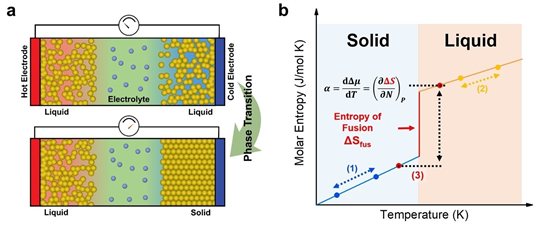
A joint research team led by Professor Kim Sangtae from the Department of Nuclear Engineering at Hanyang University and Professor Choi Wonjoon from the Department of Mechanical Engineering at Korea University has developed a new thermogalvanic energy harvesting technology based on phase transition that can effectively recover low-grade waste heat and convert it into electricity, Hanyang University announced on September 11. This technology has the potential to significantly enhance the energy efficiency of low-grade waste heat, which is set to have a significant impact on the future energy industry.
Low-grade waste heat is an energy source that occurs in relatively medium to low temperature ranges. It is generated by various industrial facilities and application devices, but is often not utilized and discarded. If this waste heat generated from factories, power plants, and automobiles is effectively recovered, it can significantly contribute to energy conservation and carbon emission reduction. In particular, if the technology to convert heat generated from electric vehicles, electronic devices, and semiconductors into electrical energy is successfully developed, the ripple effects will be significant.
Existing waste heat recovery technologies have faced limitations in continuously maintaining temperature differences in waste heat generating environments, making continuous energy generation challenging. In addition, conventional thermogalvanic cells use single-phase (solid) electrodes, which constrained performance and showed inefficiencies in recovering low-grade waste heat. To address this issue, the research team proposed a new solution that can significantly enhance thermopower by utilizing entropy changes occurring during the solid-to-liquid phase transition.
The phase transition–based thermogalvanic cells developed during this study maximized thermopower during the phase transition process by using sodium-potassium (Na-K) alloy electrodes. The research team discovered that entropy changes occurring during the phase transition temperature ranges - when the alloy electrodes transform from solid to liquid or from liquid to solid—significantly impact thermopower. Notably, during the phase transition process, the thermopower increased up to 26.1 mV/K, which is more than 10 times higher than the thermopower achieved by existing thermogalvanic cells.
The key achievement of this research lies in having developed a new electrode design and electrolyte combination that can significantly improve thermopower by leveraging thermodynamic entropy changes occurring during phase transitions. This breakthrough has enabled the development of high-efficiency thermogalvanic cells , which were previously unattainable with existing technologies. This technology not only plays a crucial role in converting low-grade waste heat into high-efficiency electric power but is also expected to contribute significantly to research on batteries and various electrochemical materials, cells, and parts.
“This research shows that by applying phase transitions and liquid metals, we can observe previously unseen properties even in well-known materials. This is expected to lead to various future studies on the applications of liquid metals and phase transitions,” said Professor Kim Sangtae of Hanyang University.
This research was conducted with support from the Samsung Science & Technology Foundation, the National Research Foundation of Korea, Leading Research Center, and the Mid-Sized Research Project . Additionally, the paper titled “Boosted Thermogalvanic Thermopower upon Solid-to-Liquid Phase Transition” was published online on August 15, 2024, in Energy & Environmental Science (IF=32.4, top 0.3%), the world’s leading journal in the fields of energy and environment, garnering significant attention in the energy and next-generation battery fields.





 '한양위키' 키워드 보기
'한양위키' 키워드 보기